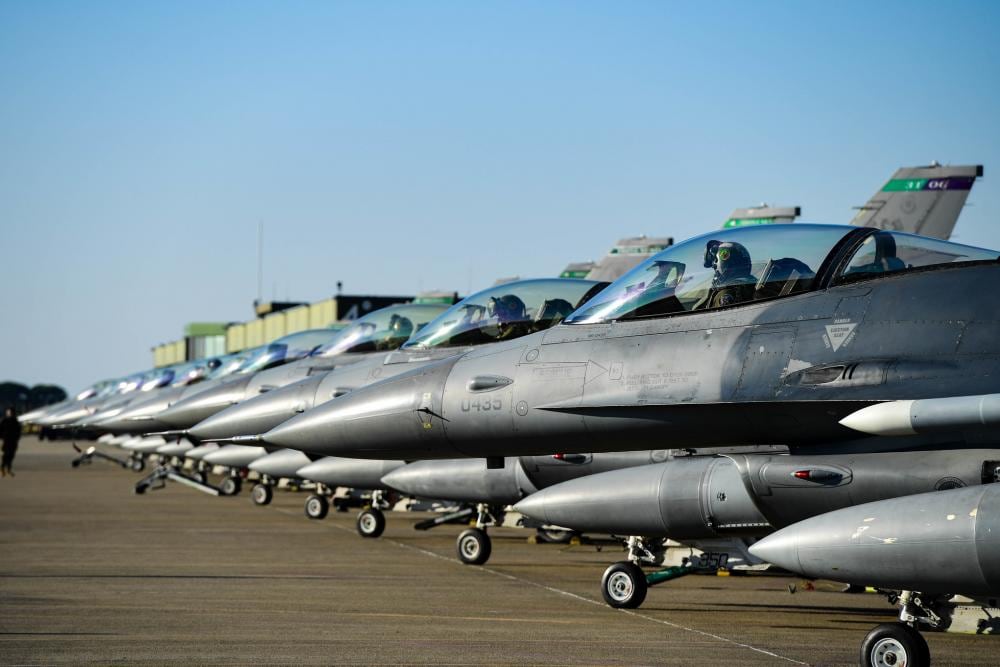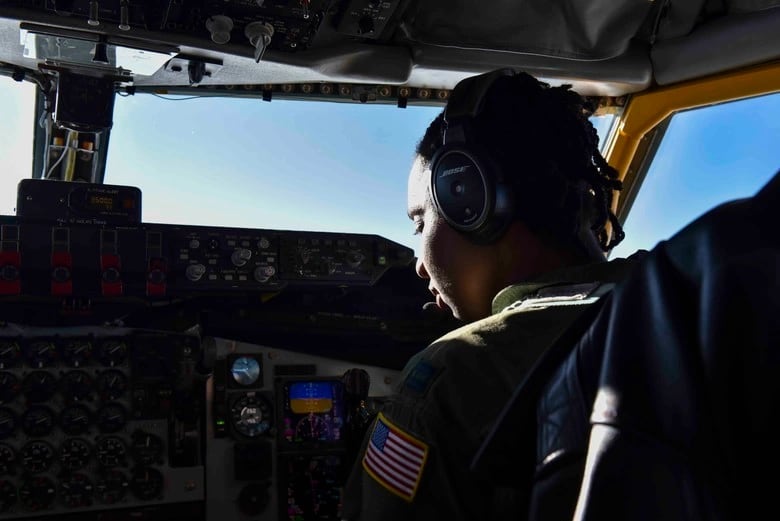This story was updated at 8:45 a.m. March 6 to include more details on pilot compensation.
The Air Force’s pilot corps is shrinking.
The service was 1,907 pilots short of its 21,000-person goal for manned aircraft as of October, according to the latest data provided to Air Force Times. That’s nearly 260 more open pilot slots than it had at the end of 2021.
A web of factors that include commercial airline hiring, military flight instructor shortages, changes in the U.S. war footing abroad, and the Air Force’s shrinking fleet has entangled the service into a long-running pilot shortfall that makes the service more vulnerable in a potential crisis. It has also snagged the Air Force’s policy shops that rely on a deep bench of expert pilots to shape the future force.
“We are managing our way through this, but it is something we are addressing,” Air Force Secretary Frank Kendall told lawmakers last May.

The service has nibbled at the edges of a 2,000-pilot shortage for years. Each year, it hopes to employ about 13,000 active duty pilots overall, plus another 8,000 or so in the Air National Guard and Air Force Reserve.
On the active duty side, the Air Force wants 741 more people to meet its goal of about 13,000 pilots, That means about 6% of active duty pilot slots sit empty and most of those job openings are in the fighter community, service spokesperson Rose Riley said. About 80 spots are available on other airframes.
The Guard and Reserve have an even wider gap, which has held steady at about 1,200 airmen across the two components. About 15% of Guard and Reserve pilot jobs are vacant.
In a crisis, defense leaders would likely call on those units first to round out active duty deployments. In addition, a shortage within the reserve component creates a thinner bench of experienced part-time airmen without sure replacements in tow.
Heather Penney, a defense expert at the Air and Space Forces Association’s Mitchell Institute for Aerospace Studies, argues the service’s plan to retire hundreds more aircraft without readily apparent replacements will make matters worse.
“In the 1990s, they divested too many aircraft, they closed down too many pilot training bases,” she said. “They simply don’t have the capacity to produce the number of pilots that they need, and they don’t have the aircraft required to absorb the pilots they do create.”
Air Force officials have seen hints of progress. The service closed out fiscal 2022 with about 200 more active duty pilots than it had three years earlier. Now, though, military officials and civilian experts alike argue the Pentagon needs to amass a more robust pilot corps to prepare for the next conflict.

Fighting the airlines for pilots
The Air Force’s efforts to bolster its number of pilots is hindered by two factors. First, the service spent more than two decades of war in Afghanistan, Iraq and Syria, where pilots were worn out by nonstop deployment. At the same time, Air Force leaders must counter the headwinds of robust civilian-sector employment.
Second, most active duty pilots head into the private sector in their mid-30s, after amassing about 10 years of flight experience, Riley said. At that point in their career, airmen make about $135,000 a year in base pay and other financial benefits, plus bonuses and combat pay. This can make them attractive candidates for commercial airlines, which are also starving for workers. There, former airmen can fly for higher pay and less paperwork and other extraneous duties.
The 12 major U.S. airlines — Alaska, Allegiant, American, Atlas, Delta, FedEx, Frontier, JetBlue, Southwest, Spirit, United and UPS — hired more than 13,000 pilots in 2022, according to data compiled by the consulting firm Future and Active Pilot Advisors.
That’s more than the previous three years combined, and the largest single-year hiring spree since 1990.
About 25% — or 3,280 — of the pilots hired by those 12 companies last year came from the military, the advisory firm told Air Force Times.
But money isn’t the only factor. Airmen leave for any combination of reasons, such as a desire for more stability at home, to avoid being shuffled into office jobs, or, simply, burnout. Others may feel like they got what they wanted out of military service, or that it’s time for a new challenge, Air Force leaders and former troops have said.

The problem has long been particularly acute in the fighter community, where airmen are upset they aren’t flying more.
Funded flying hours have fallen from 2.1 million to 1.1 million a year over the past two decades, offering pilots fewer opportunities to contribute and keep their skills current. That decline is driven by the reduction of U.S. forces in U.S. Central Command, and by the growing number of aging aircraft that need to spend more time in the shop.
“The kind of flying that Iraq and Afghanistan required was very limited, in terms of how it actually connected to real combat capabilities,” said Penney, who flew F-16 Fighting Falcon jets in the Air National Guard. “Fighter pilots — and combat pilots in general — have not felt as valued for their skill sets as, frankly, they should be.”
Solutions to the shortage
So what’s the Air Force to do?
The service has ruled out some options that are often floated as possible fixes. Some airmen want to create warrant officer positions as an alternative to the leadership track, while others endorse allowing enlisted airmen to fly manned aircraft.
Instead, the service will launch a congressionally mandated initiative to keep more “rated” officers — manned and unmanned aircraft pilots, combat systems officers and air battle managers — in 2023.
To qualify, an airman must have one to three years left in their initial 10-year service commitment. Once their 10 years are up, the program would keep pilots in the Air Force for another four.
Those who agree to stay could be guaranteed the base of their choice, and up to $50,000 in bonus pay per year — up from today’s maximum of $35,000. That’s in line with a 2021 recommendation by Rand Corp., a federally funded think tank, that the Air Force do more to understand where pilots want to live and offer more flexible job assignments.
However, the final decision on that proposal ultimately rests with the Air Force secretary, depending on the service’s needs.
“Specific details on the demonstration program are being refined and will be announced later this year,” Riley said.

How COVID exacerbated the pilot shortage
Though the problem far predates the pandemic, opponents of the Pentagon’s recently rescinded COVID-19 vaccine mandate have argued that the Air Force worsened the problem by ousting unvaccinated airmen who could otherwise be in the cockpit.
The Air Force kicked out more than 830 airmen and Space Force guardians who refused vaccination. The service hasn’t said how many of those who retired, separated or were otherwise suspended because of the vaccine mandate were pilots.
Pilot woes are one piece of the Air Force’s overall struggle to keep members.
Air Force Times previously reported that nine in 10 airmen who were eligible to leave the Air Force opted to stay in 2022, marking another year of higher-than-usual retention since the pandemic began.
Slightly more officers continued their service than enlisted airmen, 93.1% to 89.4%, according to service spokesperson Tech. Sgt. Deana Heitzman. But those numbers are again approaching pre-pandemic levels as departures eat away at the margins.
The service is aiming for more “comprehensive and integrated” talent management this year, Riley said. That means setting new retention goals, improving its fragmented and outdated human resources systems, and crunching that data to better understand the workforce.
Tobias Switzer, an adjunct senior fellow at the Center for a New American Security, argued these efforts are a case of too little, too late.
“During the pandemic, when airline jobs dried up temporarily, there was a window of opportunity to try bold retention initiatives,” he said. “But the Air Force did nothing. … There was and is still no serious policy response.”
The manpower crunch in relative peacetime doesn’t bode well for a potential war with extensive combat losses, Penney added.

In an emergency — even short of war — the Air Force could bar active duty pilots from leaving under the policy known as stop-loss. The U.S. last used stop-loss to mobilize troops in the opening years of the Afghanistan and Iraq wars from 2001 to 2011.
Leaders also considered such a tactic in 2020 as basic military training throughput slowed in the pandemic’s first year.
“Our assessment is that we don’t have to take other measures, such as stop-loss, which of course is being discussed inside of Washington. We’re not at that point yet,” Lt. Gen. Marshall “Brad” Webb, then the head of Air Education and Training Command, told reporters at the time.
Another suggestion from Rand Corp. would change the 10-year active duty service commitment into a longer but more flexible contract. That could offer airmen options for full-time and part-time work, depending on their own needs and those of the Air Force.
The change “could reduce, but not eliminate, shortages” if the number of new pilots coming in remains the same, Rand wrote. If the service can graduate more pilots, airmen could keep their shorter service commitments.
“They certainly need to look at, how can they exploit the Air National Guard as a means to capture the experienced pilots that leave the active duty, but ensure that they’re still trained and readily accessible in case something happens?” Penney said.
That’s easier said than done.
The Air Force is trying to train new pilots as quickly as possible. It has begun using iPads in undergraduate pilot training instead of paper handbooks, and more simulators to streamline parts of the process.
The service put 1,276 airmen through undergraduate pilot training last year, about 100 fewer than in fiscal 2021, Riley said. It typically aims to graduate 1,500 new pilots each year, and is shooting for 1,470 pilots in 2023.
Keeping the pipeline running smoothly was tricky in 2022. The service continues to struggle to find enough civilian workers to run flight simulators despite a slate of hiring incentives.
About one-quarter of those sim instructor jobs — 135 of 518 — remain empty.
“For every [instructor] gained, 10 Air Force student pilots can more efficiently move through the system with a timely graduation,” Riley said.

The Air Force also unexpectedly halted operations in July to inspect ejection seats on hundreds of aircraft. And an effort to overhaul T-38 Talon training jet engines is also moving slower than anticipated, keeping them out of service.
Riley said the Air Force is focused on getting the resources its training enterprise needs, improving staffing and updating its curriculum.
More drastic measures could be in the works if the pilot gap continues to grow. That could include additional workdays at flight training bases, or an overhaul of the pipeline altogether — which would come with its own challenges.
“There is no single silver bullet that would magically solve the pilot crisis,” Penney said. “If it was easy, service leaders would have figured it out by now.”
Rachel Cohen is the editor of Air Force Times. She joined the publication as its senior reporter in March 2021. Her work has appeared in the Washington Post, the Frederick News-Post (Md.), Air and Space Forces Magazine, Inside Defense, Inside Health Policy and elsewhere.





